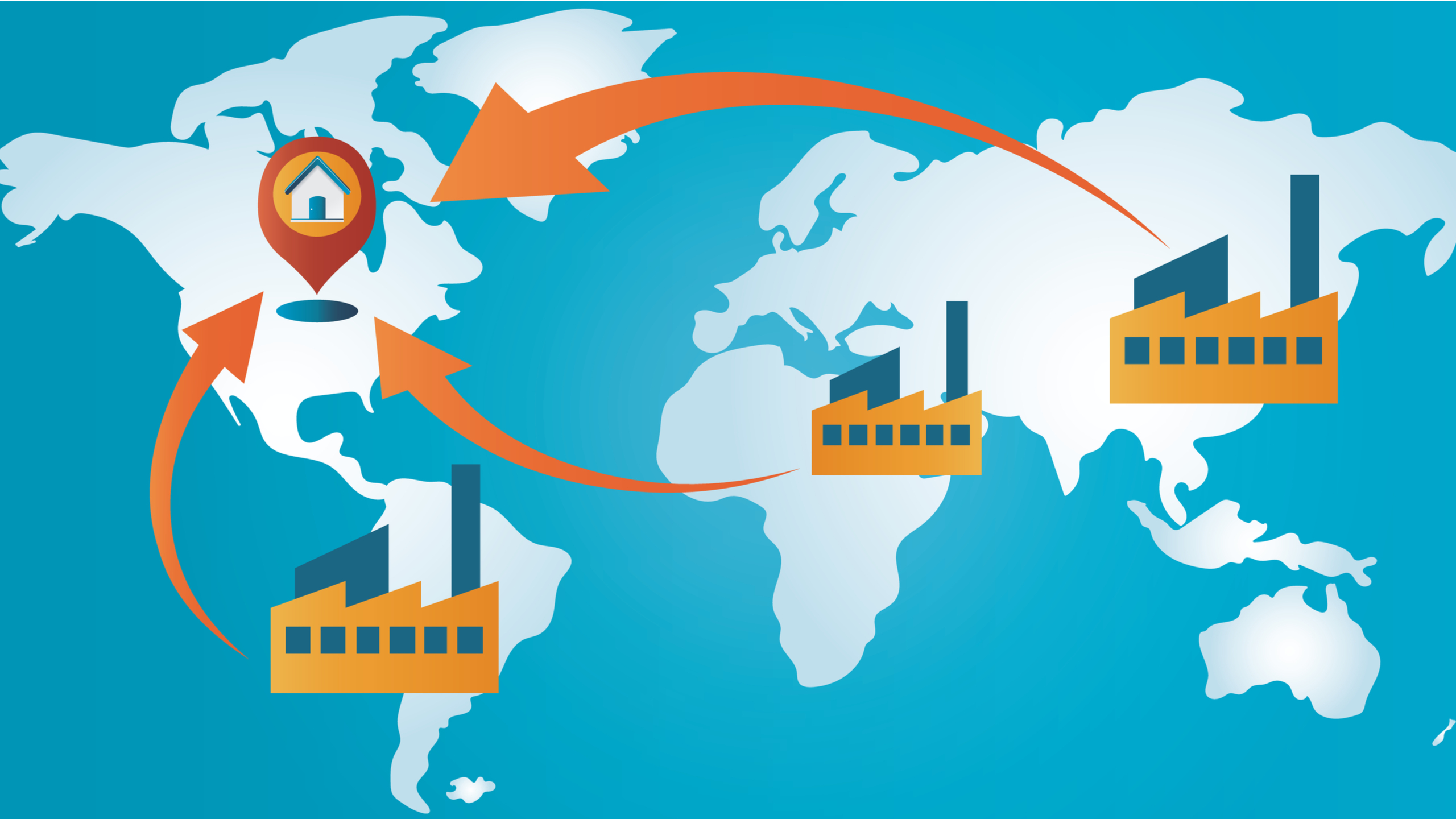Reshoring—the practice in which OEMs bring production and supply chains back from foreign countries to their home countries—and nearshoring—bringing production closer to home or to major markets—have increased in the wake of the pandemic, although not necessarily at the pace and scale which some anticipated. In looking at re/nearshoring trends and sentiments for both the United States and Europe, here’s what we found:
Re/nearshoring has been particularly disappointing in Europe. An initial surge of interest in 2020 by European executives in re/nearshoring had dissipated by mid-2021. According to surveys conducted by EY in June 2020 and June 2021, the percentage of Eurozone companies considering re/nearshoring dropped from 83% to 23% for nearshoring and 20% for reshoring. And when executives ranked the “megatrends” that they expected to accelerate most over the next three years, only 5% picked re/nearshoring. By contrast, 29% chose digital customer access to services; 17% thought sustainability and climate change would dominate; and 14% reckoned automation of manual process would accelerate fastest.
In the United States, the Reshoring Initiative has projected 220,000 new domestic jobs will be created by investments in reshoring announced through just the first half of 2021. According to the group, that was a 38% over the entire year of 2020 and “the highest yearly number recorded to date.”
Analysts like EY and Reshoring Initiative include foreign direct investment (FDI) when they tally reshoring data. In the United States, FDI has been particularly robust and accounting for 38% of the projected new jobs, according to Reshoring Initiative. In the electric vehicle battery segment alone, nearly 11,000 new jobs will come from Korean FDI in new U.S. manufacturing facilities. And the largest net jump in jobs forecast came in computer and electronics due mostly to investment in semiconductor manufacturing such as Taiwan-based TSMC’s $12 billion investment in a 5nm node fab in Phoenix, Arizona.
In Europe, FDI in manufacturing declined by 20% in 2020, according to EY. But the firm’s analysts see “reasons for optimism” in the data and forecasts for industrial producing manufacturing. After declining 12.8% in 2020, this segment was expected to grow by 9.6% in 2021 and 4.1% in 2022.
When examining corporate strategies for supply chains, the EY survey revealed “limited appetite for major supply chain restructuring.” The two top drivers, according to the 550 Eurozone executives surveyed, were reducing dependence on sole-source suppliers and countries (39%); operating more regionally (34%). After nearshoring (23%) and reshoring (20%), 19% of respondents predicted their firms would increase their manufacturing presence in Europe and 16% said a transition to lean or additive manufacturing was in the cards.
Additive manufacturing—commonly known as 3D printing—has been the subject of a great deal of buzz as the vulnerabilities of far-flung global supply chains have been revealed by disruptions related to the pandemic. “3D printing, for the first time, is giving executive leadership the power to rethink the relationship of their supply chain and internal operations by taking a holistic approach to cross-functional capacity,” said Matt Petros, CEO of 3DEO in a recent Forbes article. The firm Petros heads is one of several that has mastered 3D printing with metal, expanding the range of parts and components that can be produced.
But a deeper dive by FT reporters finds limited potential for 3D printing to replace foreign suppliers, especially those in Asia, on a large scale. In aerospace manufacturing, for example, suppliers are regulated by aviation authorities, and this makes changing to addictive manufacturing challenging. German 3D printer maker SLM told FT that a recent partnership with a UK aero-engine manufacturer took two years to get up and running due in large part to the need for approvals from Britain’s Civil Aviation Authority.
The constraints on how much and how fast 3D printing can displace foreign suppliers is part of the dominant fact of life in supply chains, according to FT and other analysts: most industries remain utterly dependent on Asian suppliers—and not just for cost reasons, but for their technical sophistication. “We have approximately 800,000 people deployed in our [suppliers’] factories,” said Kasper Rorsted, Adidas’ CEO. “It’s an illusion that you can move an industry that has grown over 30 years in Asia [and become] a very sophisticated industry.”
Rorsted added that even if a large reshoring of his company’s operation were possible, the highly technical fabrics and other materials for shoes would still need to be sourced globally. Other analysts quoted by FT point out that the EU lacks the workforce to staff major growth in manufacturing. And the cost increases associated with large-scale reshoring “would considerably worsen the standard of living for people inside the EU as well as for its trading partners,” according to Alexander Sandkamp of the Kiel Institute for the World Economy.
EY’s analysis echoes Rorsted’s and Sandkamp’s view, noting that moving out of Asia in a big way could result in “disruptive and costly reorganizations” of supply chains. “Asia is showing solid signs of recovery, and multinationals will maintain a presence there … [while] some may relocate selected critical activities to Europe, mitigating future disruption risks.”
***
Firms can indeed reap major benefits by re/nearshoring parts of a supply chain. But the core strategic principles of building resilient supply chains—mapping to the sub-tiers; monitoring events in real time; proactively mitigating risks at vulnerable suppliers making high-impact parts; etc.—must be applied to assure that the results achieved are the ones you want.
As Kearney’s experts summed up at the end of the 2020 Reshoring Index: Companies need to place more value on resilience by building supply chains that can nimbly sense and pivot in response to unexpected demands and disruptions. This is the key to operating profitably in the face of ongoing disruptions.





